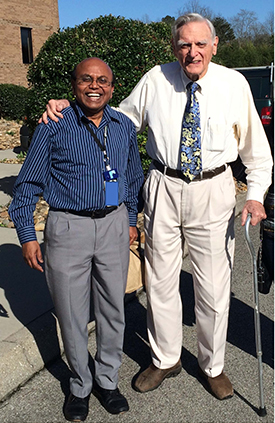Two of the researchers who share the Nobel Prize in Chemistry announced Wednesday—John B. Goodenough of the University of Texas at Austin and M. Stanley Whittingham of Binghamton University in New York—have research ties to the Department of Energy’s Oak Ridge National Laboratory, where scientists use neutrons to seek new insights into materials and chemical processes for improved battery performance.
Goodenough and Whittingham were recognized, along with Akira Yoshino of the Asahi Kasei Corporation in Tokyo, for the development of the lightweight lithium-ion battery. Their work in earlier years laid the foundation for the rechargeable batteries used to power smartphones, cameras, electric cars, tablets and lifesaving medical devices.
Years after pioneering the research that earned them the Nobel Prize, Goodenough and Whittingham made even more contributions to lithium-ion batteries using neutron scattering at ORNL’s High Flux Isotope Reactor (HFIR) and Spallation Neutron Source (SNS). Neutrons are ideal for studying lithium because they are nondestructive and highly sensitive to light elements like lithium.
Between 2010 and 2016, ORNL collaborated with Goodenough on a successful project supported by DOE’s Office of Basic Energy Sciences (BES) entitled, “Materials and Interfacial Chemistry for Next-Generation Electrical Energy Storage.”
“The goal was to provide predictive understanding of the structure, interfaces and properties of certain materials to enable the realization of a safe, rechargeable battery for electric energy storage,” said Sheng Dai, a leader of the Nanomaterials Chemistry group at ORNL. “We wanted to develop a battery with a high enough energy density and rate of energy storage and delivery at a low enough cost that would make it competitive with fossil fuels.”
According to Dai, the project greatly benefited from several facilities and capabilities at ORNL, especially HFIR and SNS, which were essential to elucidating detailed chemical processes happening in solid-electrolyte interphases and cathode materials.
“The elemental sensitivity of the neutron methodologies is crucial to the atomistic structural characterization of battery materials, which is impossible or very difficult to achieve via any other characterization method,” said Dai.

“The fundamental understanding gained from such neutron scattering studies provides the foundation for the next-generation energy storage technologies,” said Neutron Sciences Associate Lab Director Paul Langan.
In the last 10 years, Goodenough made prolific use of ORNL’s suite of neutron scattering instruments at HFIR and SNS which led to a series of impactful publications and is paving the way for the next generation of researchers to carry on.
M. Parans Paranthaman, leader in ORNL’s Materials Chemistry group, did his postdoctoral research with Goodenough from 1988 to 1991 and worked with him from 2010 to 2016 on the BES materials science project.
“Professor Goodenough is a great inspiration for all of us. You can hear Professor Goodenough’s laugh anywhere in the building if he is around. He is a very sharp and easily accessible person,” said Paranthaman.
He said Goodenough, in 2015, at age 93, was writing his paper and patent application while he was traveling on a plane from Nashville to Knoxville.
“He is such a hard working and dedicated person. He is a role model for all of us.”
Goodenough, 97, is the oldest Nobel laureate, but is still very active in research. The three winners will share more than $900,000 in prize money. The announcement was made at the Royal Swedish Academy of Sciences on Wednesday morning.
From the Nobel citation: “Goodenough predicted that the cathode would have even greater potential if it was made using a metal oxide instead of a metal sulphide. After a systematic search, in 1980 he demonstrated that cobalt oxide with intercalated lithium ions can produce as much as four volts. This was an important breakthrough and would lead to much more powerful batteries.”
Goodenough’s and Whittingham’s relevant publications using neutron scattering at ORNL include:
- “Orbital fluctuations and orbital flipping in RVO3 perovskites” (2007), Physical Review Letters
- “Spin-state transitions in PrCoO3 studied with neutron powder diffraction” (2011), Physical Review B
- “Statics and dynamics of the highly correlated spin ice Ho2Ge2O7” (2012), Physical Review B
- “Temperature dependence of aliovalent-vanadium doping in LiFePO4 cathodes” (2013), Chemistry of Materials
- “Y1-xLax VO3: Effects of doping on orbital ordering” (2014), Physical Review B
- “Neutron Diffraction and Electrochemical Studies of Na0.79CoO2 and Na0.79Co0.7Mn0.3O2 Cathodes for Sodium-Ion Batteries” (2014), Journal of The Electrochemical Society
- “Dynamic Distortions in the YTiO3 Ferromagnet” (2014), Journal of the Physical Society of Japan
- “Electronic and electrochemical properties of Li1-xMn1.5Ni0.5O4 spinel cathodes as a function of lithium content and cation ordering” (2015), Chemistry of Materials
- “Removal of Interstitial H2O in Hexacyanometallates for a Superior Cathode of a Sodium-Ion Battery” (2015), Journal of the American Chemical Society
- “Charge disproportionation and the pressure-induced insulator-metal transition in cubic perovskite PbCrO3” (2015), Proceedings of the National Academy of Sciences of the United States of America
- “Insulating Pockets in Metallic LaNiO3” (2016), Advanced Electronic Materials
- “Lattice and magnetic dynamics in perovskite Y 1 − x La x TiO” (2016), Physical Review B
- “Anomalous bulk modulus in vanadate spinels” (2016), Physical Review B
- “Slater Insulator in Iridate Perovskites with Strong Spin-Orbit Coupling” (2016), Physical Review Letters
- “High-pressure synthesis and characterization of the effective pseudospin S=1/2 XY pyrochlores R2Pt2O7(R=Er,Yb)” (2016), Physical Review B
- “New mechanism for ferroelectricity in the perovskite Ca2-xMnxTi2O6 synthesized by spark plasma sintering” (2018), Journal of the American Chemical Society
- “Identifying the chemical and structural irreversibility in LiNi0.8Co0.15Al0.05O2 – a model compound for classical layered intercalation” (2018), Journal of Materials Chemistry A
SNS and HFIR are DOE Office of Science User Facilities. ORNL is managed by UT-Battelle LLC for the DOE Office of Science, the single largest supporter of basic research in the physical sciences in the United States. The Office of Science is working to address some of the most pressing challenges of our time. For more information, visit https://energy.gov/science.—by Jeremy Rumsey





